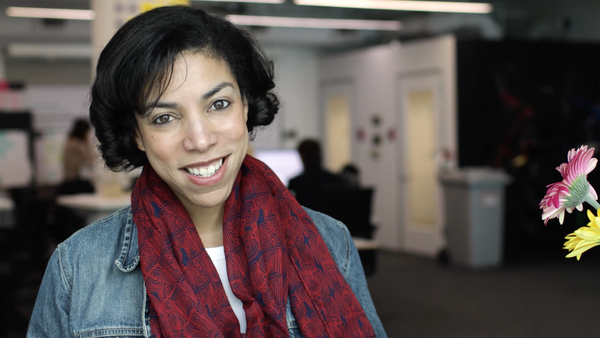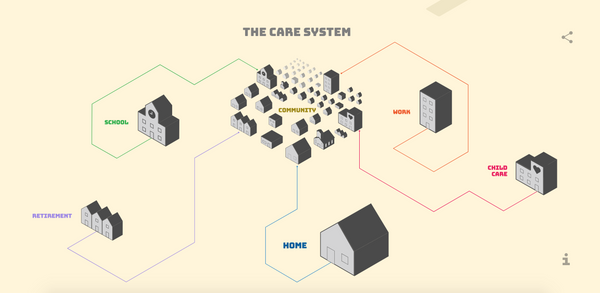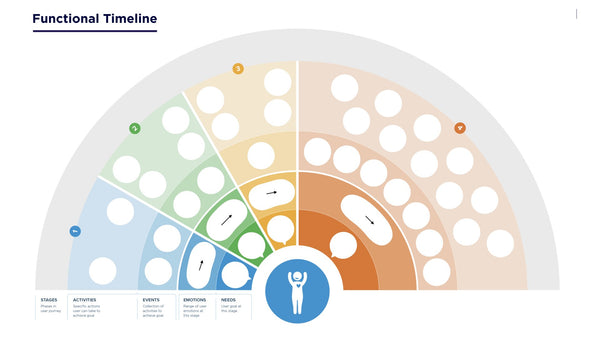Tackle Your Journey Map Roadblocks with These Tips

How do you evolve a customer journey map from a tool that inspires and explains to one that creates action? In this episode of our Creative Confidence Series, hear tips for this and other service design challenges, and learn how IDEO Partner and Managing Director Melanie Bell-Mayeda and her team are evolving the practice of service design with stories from the latest work at IDEO. She expands on the lessons she teaches in our Human-Centered Service Design course with tips for moving from a high-level and inspiring customer journey map toward real action, breaking a massive service design challenge into more manageable parts, and picking the right moment that matters in a customer journey.
Journey maps can look like a lot of things. But a framed image on the wall or a filename with “final” are not likely to be one of them if you’re using a journey map the right way.
Melanie Bell-Mayeda has been designing service journeys for clients at IDEO for more than 12 years. She says the biggest mistake you can make is to think of a journey map as a final product and to slide into optimizing instead of staying in a beta-testing mindset. It might feel risky to shake things up when they’re seemingly not broken, but for a service to remain delightful, it has to stay fresh.
“If you haven't been testing your way forward, that gives someone else the opportunity to come in and cherry pick off your best customers, or deliver something to them that you hadn't really thought of because you remained in optimization mode,” Melanie says.
In this episode of our Creative Confidence Series podcast, Melanie shares more lessons she’s learned from her recent service design work at IDEO. In a conversation with IDEO U Dean Suzanne Gibbs Howard, Melanie talks about three projects that pushed her and her team to move their service design practice forward.
Turning inspiration into action
A journey map should capture the big picture of your customer’s overall experience—not just the moments with you, but everything leading up to and after they engage with you as well. For an organization, journey maps can be an immensely helpful tool for connecting deeply with your customers, understanding what the experience is like now, imagining what it could be in the future, and getting inspired to make change. But a roadblock often rears its head when you take that beautiful, inspiring, and very human picture and ask, “So...what do we do now?”
Melanie’s team faced this exact challenge when working with a large healthcare organization to reimagine their services to embrace a more holistic view of wellness. IDEO began by telling the story of all of their different stakeholders and imagining their experience three to five years from now. The output was an illustration of customer journeys that would inspire and rally everyone around a clearly articulated future state.
And inspire they did. But the client felt lost in how to take action on that future vision. So the IDEO team mapped those narrative journeys to a functional journey map and timeline that would allow the healthcare team to activate their ideas and prioritize which projects to take on first.
The functional timeline broke out a series of stages of the customer journey, each mapping back to the user’s needs, their feelings in that moment, major events, and specific activities and touchpoints that could shape their experience. This plan helped the team always start with the user need and circle back to it again once they had designed a solution. The end goal was the same—envision and enact an emotional transformation for the customer—but this functional timeline went farther by breaking down exactly how to bring that idea to life.
Download this functional timeline template >
Breaking a massive challenge into smaller parts
Sometimes a project is so big that the hardest part is figuring out where to start. In the last year, Melanie and her team have been working on a project with Pivotal Ventures in partnership with Melinda Gates to take on the topic of caregiving. Caregiving, from childcare to elder care, stretches into so many parts of our lives, touching our school systems, home life, work, retirement, and more. And many parts of caregiving are service design challenges. Redesigning this system felt like such a huge and insurmountable project that the team struggled with where to start.

Ultimately, what worked was breaking the topic of caregiving into smaller parts and creating a series of design sprints to explore the biggest opportunities for change.
“We didn't want to create a solution in a vacuum,” Melanie says. “But actually create something that we could prototype and put back into the hands of people. And do it at scale.”
First, the team researched and identified 35 opportunities for projects. Then they narrowed it down to 15 big questions that had the potential to have an outsized impact on the care system. For each of the 15 projects they identified a key question to answer and paired it with an external partner, like a nonprofit or governmental agency, who had expertise and influence in that area. From there, the team ran design sprints for each project.
Each sprint lasted anywhere from one to six weeks. The team kicked off with in-depth research. Then, they sketched out a journey map, picked a moment to focus on, designed a service experience, put it out into the world as a prototype, got feedback, then incorporated that feedback into a recommendation for the partner to apply that solution in the real world. The project is shared at likewe.care.
The team was flexible in how they approached each sprint, as each project brought different challenges. “Use the model, but don't be afraid to break it,” Melanie says.
The key is creating structure around a short amount of time. Make sure you've gotten to a clear question, that you've designed for that question, that you've tested it, and that you have something you can move forward and implement.
Finding the right moment that matters
One of the projects from the Pivotal work surfaced another common service design challenge—how do you know which moments are the ones that really matter to prototype?
UrbanSitter is a service that helps you find and book babysitters and nannies of people you know and trust by tapping into your network. They knew how to reach moms, but wanted to get dads on board with the service, too. During the design sprint for this service, the IDEO team had a hypothesis that a moment that mattered was advertising—that messaging to dads more would help drive adoption. But as they were prototyping this hypothesis, they discovered an even bigger opportunity than getting dads on board with the idea. The app interface made it hard for parents to share an account. That discovery ultimately led to a breakthrough.
“It's better to get started than to wait to find the perfect moment,” Melanie says. Don’t let setbacks knock the wind out of you and kill your momentum. Have a hypothesis but don’t be attached to the solution. If prototyping a particular moment unlocks something new, that's fantastic because it's been lower risk, lower cost, and it's helped you to get to the better moment.
“By prototyping that moment, we were able to find the bigger moment that really mattered in that service,” Melanie says.
If you’re struggling to find the right moment to prototype, Melanie shared a few pieces of advice.
“Go to the edge of what might be unexpected,” she says. “Take those leaps of faith, and take those risks and prototype.”
For example, the Ritz-Carlton hotel found that customers loved it when they had a bagpipe player at sunset—so much so that they constantly received letters and emails about it. They ended up making it a permanent tradition. Just make sure you’re listening to customer feedback, too. The bagpipe playing was risky. Guests could have preferred quiet time instead. The hotel only knew it was working by paying attention to feedback.
Also, don’t seclude the design process to a handful of senior leaders. Find memorable moments by going to frontline staff. Are there things customers already love that could scale?
“Your memorable moment might be right in front of you,” Melanie says.
Pain is part of the process
As these service design challenges have pushed her team to new places, she’s inspired by the thought that disruption requires some amount of pain.
“To truly disrupt, something has to break,” Melanie says. “Something almost needs to hurt to get there.” And by "break" Melanie means that you’ve got to take risks and try out hypotheses that may not work. In the end you'll learn and arrive at something better.
This idea, from a book she’s reading called The Practice of Adaptive Leadership, doesn't mean that innovation always has to be painful. But when you choose to move farther into that disruptive space, you’ll know it because it's really, really hard. But it’s also incredibly rewarding and fun.
She’s trying to find that balance. “How do I keep pushing to get to that point of both a little bit of the pain, but also a lot of the joy?”
“There's so much joy in trying something new,” Melanie says.
Learn more about designing the moments that matter in our Human-Centered Service Design online course.
- choosing a selection results in a full page refresh
- press the space key then arrow keys to make a selection




